


9 months ago
street fashion photography, Fantasy Fashion upper body photo of a 24 year old Cajun-Rajasthani female artistic beauty with Steely determination expression. Her body is Sculpted lats that create a strong, tapered back, toned muscles, abs, small breast, flat chest. She has Dark skin with cool undertones, appearing even and smooth under all lighting. The skin pores and texture are clearly visible and in focus. Her Oval with a pointed tip, Classic, light hazel eyes, framed by long, elegant eyelashes. Her haircut is Mohawk where the center is styled to look like a zipper. Her haircolor is Fairy dust rose gold. Her eyebrows are Soft arch with a peak shaped, complementing her delicate facial features. She is dressed with Rough-textured cropped vest, midriff, Low-rise leather leggings, She is posed on the left side in the image frame by the rule of thirds. She poses Kneeling on one knee, sword planted in the ground. in the background Fog-enshrouded lake with a single boat lights Warm, golden glow from an ancient lantern the model is lighted with soft natural lighting in the style of Chris Riddell

9 months ago
A serene yet intense scene in a dense, ancient forest during the stillness of twilight. A woma, one of her breasts are showing, dressed in traditional Edo-period attire stands prominently in the frame, her upper body filling much of the composition. Her revealing garment, a loosely draped kimono, slips off one shoulder, fully exposing one breast, naturally presented in the scene. The fabric of her kimono, patterned with delicate floral designs, flows gently in the breeze, its vibrant reds and deep blues contrasting with the muted greens and browns of the forest. She holds a traditional Edo-period katana, its single, elegant hilt tightly wrapped in black silk, close to her face with both hands. The katana is proportioned perfectly, its slightly curved blade sharp and gleaming, reflecting the faint light of the crescent moon filtering through the towering trees. The polished steel captures the intricate patterns of folded metal, a hallmark of masterful Edo-period craftsmanship. The tsuka (handle) is a balanced, functional length, designed for precision, while the blade remains practical and deadly, fitting the refined nature of the scene. The faint reflection of a shadowy demon lingers in the blade, its ominous presence hinting at the unseen threat in the forest. Her expression is calm yet resolute, her eyes closed as though in prayer or deep contemplation, her soft features lit faintly by streaks of moonlight piercing through the canopy. Her hair, slightly disheveled, falls loosely around her shoulders, adorned with a simple hairpin, adding a touch of elegance. The breeze stirs her hair and the folds of her kimono, creating a sense of motion against the tranquil backdrop. Around her, autumn leaves fall gracefully, their vibrant reds and oranges contrasting with the muted greens and browns of the forest. Some leaves drift close to the viewer, framing her within the layered composition of the forest. The forest floor, moss-covered and bathed in soft moonlight, adds texture and grounding to the scene. The interplay of light and shadow creates long, dramatic highlights across her form and the intricate folds of her clothing. The katana’s blade glimmers, reflecting both the faint moonlight and the ominous shadow of the demon, as though the weapon itself is warning of the danger to come. The atmosphere is thick with tension, as though the forest itself holds its breath. The dynamic interplay of falling leaves, light and shadow, and the woman’s serene pose creates a cinematic and deeply emotional moment. The balance of elegance and quiet intensity evokes a timeless connection to the strength and grace of Edo-period Japan.

7 months ago
A hyper-realistic, ultra-detailed full-body front-view depiction of a tall, well-proportioned British woman with a neutral expression. She stands at 173 cm with an ample bust (34F), a defined waist, balanced hips, and long, well-structured legs, her flawless skin illuminated by cinematic-style lighting that enhances her natural contours with soft gradients and subtle shadows. Her facial features include an oval face shape, high cheekbones, a soft yet well-defined jawline, full symmetrical lips closed in a neutral expression, hazel almond-shaped eyes, dark brown arched eyebrows, and a proportional nose subtly implied for balance. Her collarbones are delicate and softly defined, avoiding overly prominent or sunken lines. Her dark brown hair is styled in a messy bun with a few loose strands framing her face, creating a warm, smooth, and effortless look. She is wearing a form-fitting gray high-neck turtleneck mini dress that accentuates her curves while maintaining elegance, ending mid-thigh to showcase her long legs, paired with sleek black knee-level boots for a modern touch. The lighting setup uses a soft cinematic style , with a key light positioned slightly off-center to create gentle highlights on one side of her face and body, while a fill light reduces harsh shadows on the opposite side. A subtle rim light is added behind her to separate her silhouette from the background, enhancing depth and dimension. The light has a warm tone with smooth transitions between highlights and shadows, evoking a natural yet dramatic effect. She stands in a true full-body, head-to-toe, wide-framed, front-facing pose with her feet flat on the ground, ensuring her entire physique is fully visible without cropping. The camera is positioned at a neutral height directly in front of her, capturing her entire height in a single frame. The background is plain and neutral, focusing attention on her body proportions, while the cinematic lighting enhances realism by creating depth and texture without extreme contrast. The image is shot in HDR 4K with ultra-detailed textures, extreme photorealism, cinematic quality, true-to-life proportions, and no distortion.
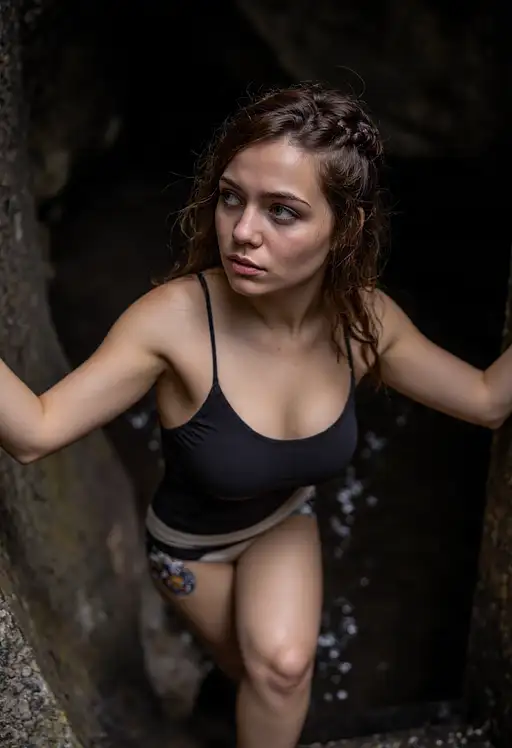
4 months ago
A woman stands at the mouth of the cave, her physique radiating through every detail of her appearance like a work of art that's been carefully crafted by the finest hands. Her single braid brunette hair is intricately woven, framing her face and adding a touch of elegance to the scene. Light blue eyes sparkle with a hint of intensity, like a whispered promise that's been shared with no one. A tank top clings to her body, showcasing her toned physique and adding a touch of sensuality to the scene. Cargo pants hang loose around her midriff, seeming to be made for comfort rather than style like a whispered promise that's been shared with no one. She leans against the rock wall, her muscles rippling beneath her skin as if she's been exerting herself. Sweat beads on her forehead, adding a touch of authenticity and humanity to the scene like a whispered promise that's been shared with no one. Dark and damp surroundings seem to envelop her, adding a sense of mystery and adventure to the moment like a work of art that's been carefully crafted by the finest hands. Bokeh effects blur the background, adding a sense of intimacy and quiet contemplation to the moment like a secret that's been shared with just one person. Every detail of this image feels alive and tangible, like a moment that's been captured at its very best.

7 months ago
Abstract Full-Body Portrait of a Prostitute – Salvador Dalí (Late-Life Style, Singular Focus & Pure Surrealism) (Surrealism:1.7, Salvador Dalí late-life style:2.0, Dreamlike distortion:1.6, Hyperreal textures:1.5, Chiaroscuro contrast:1.4, Oil-painting brushstrokes:1.5, Organic fluidity:1.6, Metaphysical realism:1.4) A full-body surrealist portrait of a prostitute, painted in the unmistakable late-life style of Salvador Dalí, where dream logic dictates form and reality bends into its own subconscious reflection. She stands alone in the void, a lone figure frozen in motion yet melting into time itself. Her body is elongated but coherent, her limbs refined into one singular, fluid, organic motion, as if she is a sculpture made of half-formed candle wax, melting at the edges but never fully dissolving. Her face remains untouched by distortion, hyperreal and melancholic, eyes darkened with kohl, staring directly outward, unblinking, as if confronting time, fate, and the fabric of reality itself. A single strand of jet-black hair escapes from her carefully pinned curls, swaying in an invisible breeze. Her lips—painted a deep, blood-red—drip slightly at the edges, as if smeared by unseen hands, caught between seduction and sorrow. Her dress, a relic of the past, is a contradiction of luxury and decay, the hem transforming into thin wisps of smoke, curling and dispersing into the canvas. The fabric is stretched unnaturally, its folds elongating like the melted forms of Dalí’s classic clocks, one shoulder slipping in an eternal descent, never quite falling. The setting is an infinite, surreal landscape—a lonely street with no visible end, where shadows stretch longer than their owners, and the cobblestones appear to melt into liquid mercury. In the background, a large, antique pocket watch, twisted and partially submerged in the air, hangs frozen at an uncertain hour, its hands warped into elongated spirals. A single red rose, impossibly large and impossibly alive, hovers just behind her, its petals peeling away like fragments of forgotten love letters. The air feels thick, painted with visible brushstrokes, where light and shadow do not obey the laws of physics—instead, they bleed into one another, wrapping around her body in soft, liquid chiaroscuro, mimicking the curvature of a dream. She is not merely a woman but a symbol—of desire, of loss, of something slipping through time like sand through Dalí’s own fingers.
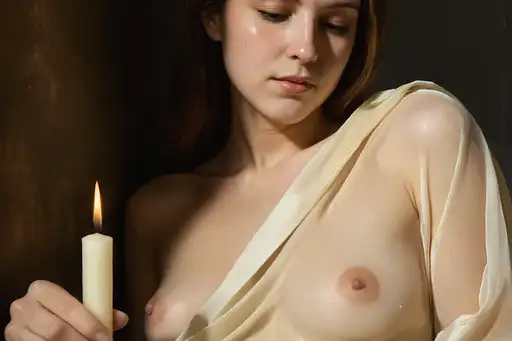
4 months ago
diaphanous ivory robe slipping off one shoulder::1.4 dramatic chiaroscuro with deep shadow enveloping half her form and a single candlelit god-ray grazing her face::1.6 oil on canvas in the style of Caravaggio::1.7 fine yet bold brushwork capturing glint on the camera lens, rich ochres and burnished umbers in the background::1.5

9 months ago
A serene yet intense scene in a dense, ancient forest during the stillness of twilight. A woma, one of her breasts are showing, dressed in traditional Edo-period attire stands prominently in the frame, her upper body filling much of the composition. Her revealing garment, a loosely draped kimono, slips off one shoulder, fully exposing one breast, naturally presented in the scene. The fabric of her kimono, patterned with delicate floral designs, flows gently in the breeze, its vibrant reds and deep blues contrasting with the muted greens and browns of the forest. She holds a traditional Edo-period katana, its single, elegant hilt tightly wrapped in black silk, close to her face with both hands. The katana is proportioned perfectly, its slightly curved blade sharp and gleaming, reflecting the faint light of the crescent moon filtering through the towering trees. The polished steel captures the intricate patterns of folded metal, a hallmark of masterful Edo-period craftsmanship. The tsuka (handle) is a balanced, functional length, designed for precision, while the blade remains practical and deadly, fitting the refined nature of the scene. The faint reflection of a shadowy demon lingers in the blade, its ominous presence hinting at the unseen threat in the forest. Her expression is calm yet resolute, her eyes closed as though in prayer or deep contemplation, her soft features lit faintly by streaks of moonlight piercing through the canopy. Her hair, slightly disheveled, falls loosely around her shoulders, adorned with a simple hairpin, adding a touch of elegance. The breeze stirs her hair and the folds of her kimono, creating a sense of motion against the tranquil backdrop. Around her, autumn leaves fall gracefully, their vibrant reds and oranges contrasting with the muted greens and browns of the forest. Some leaves drift close to the viewer, framing her within the layered composition of the forest. The forest floor, moss-covered and bathed in soft moonlight, adds texture and grounding to the scene. The interplay of light and shadow creates long, dramatic highlights across her form and the intricate folds of her clothing. The katana’s blade glimmers, reflecting both the faint moonlight and the ominous shadow of the demon, as though the weapon itself is warning of the danger to come. The atmosphere is thick with tension, as though the forest itself holds its breath. The dynamic interplay of falling leaves, light and shadow, and the woman’s serene pose creates a cinematic and deeply emotional moment. The balance of elegance and quiet intensity evokes a timeless connection to the strength and grace of Edo-period Japan.
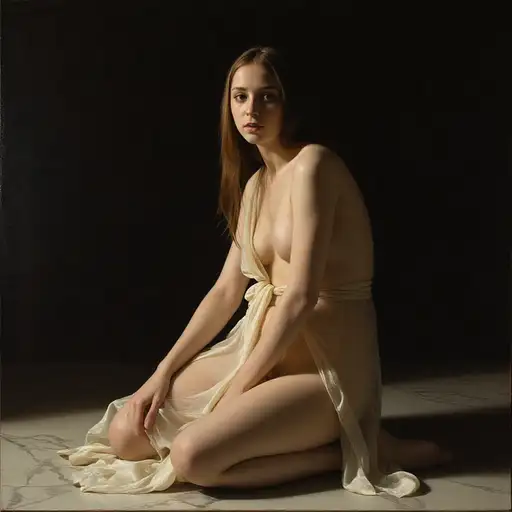
4 months ago
diaphanous ivory robe slipping off one shoulder::1.4 dramatic chiaroscuro with deep shadow enveloping half her form and a single candlelit god-ray grazing her face::1.6 oil on canvas in the style of Caravaggio::1.7 fine yet bold brushwork capturing glint on the camera lens, rich ochres and burnished umbers in the background::1.5

9 months ago
A serene yet intense scene in a dense, ancient forest during the stillness of twilight. The woman’s upper body fills the frame, her presence calm yet commanding. She holds a single, traditional Edo-period katana close to her face with both hands, the blade’s slightly curved edge gleaming faintly in the moonlight filtering through the towering trees. Her revealing kimono has slipped off one shoulder, clearly exposing one bare breast (visible and natural:1.8) while the other side remains draped, adding elegance and balance. The fabric, patterned with intricate floral designs, flutters gently in the wind, its vibrant reds and deep blues contrasting with the muted greens and browns of the forest. Her eyes are closed, her expression somber and contemplative, as though in prayer or deep focus. The katana’s blade reflects both the faint crescent moonlight and the ominous shadow of a demon, its smoky form hinted at in the polished steel. The hilt (tsuka) is tightly wrapped in black silk, simple yet refined, a testament to the weapon’s craftsmanship and purpose. The breeze stirs her slightly disheveled hair, adding subtle motion that complements the flowing fabric of her kimono. Around her, autumn leaves drift gracefully, their vivid reds and oranges framing her figure and creating depth in the composition. The interplay of light and shadow highlights the soft curves of her exposed form, the intricate details of her clothing, and the katana’s masterfully forged blade. The atmosphere is thick with quiet intensity, as though the forest itself holds its breath. The composition focuses entirely on her upper body, drawing attention to the poised katana, the reflection of unseen danger, and the serene yet powerful energy of her presence.

7 months ago
(Full-body shot, fine art noir photography, 1950s–1960s vintage setting, cinematic chiaroscuro lighting, ultra-realistic rendering, moody and atmospheric, sensual yet elegant, masterful composition, soft film grain, rich textures, timeless erotica aesthetic) A seductive nude woman stands in a dimly lit 1950s boudoir, her back to the camera, the curve of her spine accentuated by the flickering glow of a single vintage table lamp. A lush black fur boa drapes across her bare shoulders, cascading down her arms, its luxurious texture framing the smooth, radiant skin beneath. Silk stockings hug her legs, their delicate sheen catching the ambient light, a subtle garter barely visible. Her posture is both effortless and deliberate, hips slightly tilted, her weight shifted onto one foot, evoking a raw yet refined sensuality. A hazy mirror reflects just enough of her face in profile, lips painted a deep red, parted slightly as she gazes at her own reflection—lost in thought, desire, or a silent secret only she knows. The room exudes mid-century allure—a velvet chaise lounge, a half-empty glass of whiskey on a dark wood vanity, soft shadows stretching across plush drapes and antique furniture. The atmosphere is thick with desire, erotic yet sophisticated, a scene torn from the golden age of film noir where temptation lingers in the air, and every detail whispers luxury, mystery, and seduction.

2 months ago
The image shows a woman with long, dark hair elegantly posed on a light-colored sofa in a minimalist room. The scene is illuminated by strong, direct sunlight coming from the right, which creates prominent shadows across the floor and furniture. Center: The woman is the central subject, positioned on the right-hand side of the sofa as viewed by the observer. Her body is angled toward the left, while her head is turned to face the camera directly. Foreground: In the bottom-left corner, there is a portion of a brown, textured rug. The rest of the foreground consists of a light-colored floor with long, dark shadows cast diagonally from right to left. Background: Behind the woman and the sofa, there is a plain, light-colored wall. Set into the wall are two recessed rectangular shelves, one above the other. Each shelf holds a single, light-colored vase. To the far left, a double electrical socket is visible on the wall. The Woman: She is wearing a form-fitting, black, long-sleeved dress with a square neckline that ends around her knees. Her legs are crossed, and she is wearing black, pointed-toe high heels with thin ankle straps fastened by small gold buckles. She is accessorized with gold-colored hoop earrings. One arm is bent with her hand behind her head, and the other arm rests on the back of the sofa. Her hair is dark, long, and straight, and she is looking directly at the camera with a neutral expression. The Sofa: The sofa is a modern design, upholstered in a light beige or off-white textured fabric. It features clean lines, square arms, and is supported by slender, cylindrical chrome legs. The Room: The room has a minimalist aesthetic. The walls and floor appear to be a smooth, matte, off-white or very light beige color. The two vases in the wall niches are a similar light, neutral color with a matte finish. Lighting: The lighting is high-contrast, indicating a strong light source like the sun is entering from a window or opening on the right side of the scene. This creates sharp, well-defined shadows of the window frame on the floor and sofa.

4 months ago
(Primary Subject: Emotionally Expressive Android Woman with Dual-Layered Skin, Painted in Impressionist Classical Renaissance Style, 1.7 weight) — in the heart of a lush, sun-drenched garden overflowing with blossoms, an android woman stands quietly, her form captured in the painterly elegance of a Renaissance-era oil painting. Her body is sculpted and graceful, rendered with soft impressionist brushstrokes that blend into surreal detail—her figure radiant, yet ethereal, like a machine-angel frozen in time. Her “skin” is composed of two delicate, interwoven layers: The outer layer is smooth, reflective, and subtly fluid, shimmering with hints of pale pink, soft violet, and dusky gold, like liquid mercury caught in a sunset. It has the appearance of gently flowing molten glass, and catches the dappled garden light with painterly elegance. Beneath it, faintly visible through the translucent surface, lies a subdermal lattice—a softly glowing core of golden circuitry, like sacred geometry woven into synthetic muscle. It pulses faintly, like a slow heartbeat of light, giving her form an inner radiance, a soul made of signal (subtle luminous inner structure beneath transparent surface, 1.6 weight). She wears no armor, no exposed wires—only that liquid-smooth surface, glowing softly in the sun. A thin, continuous line of amber-orange light traces up the outside of her legs, over her hips, across her shoulders and arms, like a haloed signature etched into her form. Her visor-like faceplate—a curved golden-glass surface—reflects the garden’s warm light. Though faceless, her entire body language conveys profound emotion: one hand lightly touching her chest, the other extended gently toward a single open flower, as if remembering something. Her posture is soft, tender, almost melancholic—like a saint carved from future metal, lost in sacred thought. The garden blooms around her in classical beauty—roses, lilies, orchids, and surreal blossoms from impossible species. Sunlight pours through foliage in golden beams, casting her figure in a divine backlight. Petals drift in the air like thoughts. Her reflection shimmers faintly in a nearby pool. Rendered in the style of a classical oil painting—with visible brush textures, soft baroque lighting, volumetric haze, and subtle chiaroscuro across her form. The colors are rich and warm—sunset gold, floral crimson, blush pink, and soft lavender—interplaying with reflections in her skin like a moving canvas.

6 months ago
(Primary Subject: Emotionally Expressive Android Woman with Dual-Layered Skin, Painted in Impressionist Classical Renaissance Style, 1.7 weight) — in the heart of a lush, sun-drenched garden overflowing with blossoms, an android woman stands quietly, her form captured in the painterly elegance of a Renaissance-era oil painting. Her body is sculpted and graceful, rendered with soft impressionist brushstrokes that blend into surreal detail—her figure radiant, yet ethereal, like a machine-angel frozen in time. Her “skin” is composed of two delicate, interwoven layers: The outer layer is smooth, reflective, and subtly fluid, shimmering with hints of pale pink, soft violet, and dusky gold, like liquid mercury caught in a sunset. It has the appearance of gently flowing molten glass, and catches the dappled garden light with painterly elegance. Beneath it, faintly visible through the translucent surface, lies a subdermal lattice—a softly glowing core of golden circuitry, like sacred geometry woven into synthetic muscle. It pulses faintly, like a slow heartbeat of light, giving her form an inner radiance, a soul made of signal (subtle luminous inner structure beneath transparent surface, 1.6 weight). She wears no armor, no exposed wires—only that liquid-smooth surface, glowing softly in the sun. A thin, continuous line of amber-orange light traces up the outside of her legs, over her hips, across her shoulders and arms, like a haloed signature etched into her form. Her visor-like faceplate—a curved golden-glass surface—reflects the garden’s warm light. Though faceless, her entire body language conveys profound emotion: one hand lightly touching her chest, the other extended gently toward a single open flower, as if remembering something. Her posture is soft, tender, almost melancholic—like a saint carved from future metal, lost in sacred thought. The garden blooms around her in classical beauty—roses, lilies, orchids, and surreal blossoms from impossible species. Sunlight pours through foliage in golden beams, casting her figure in a divine backlight. Petals drift in the air like thoughts. Her reflection shimmers faintly in a nearby pool. Rendered in the style of a classical oil painting—with visible brush textures, soft baroque lighting, volumetric haze, and subtle chiaroscuro across her form. The colors are rich and warm—sunset gold, floral crimson, blush pink, and soft lavender—interplaying with reflections in her skin like a moving canvas.
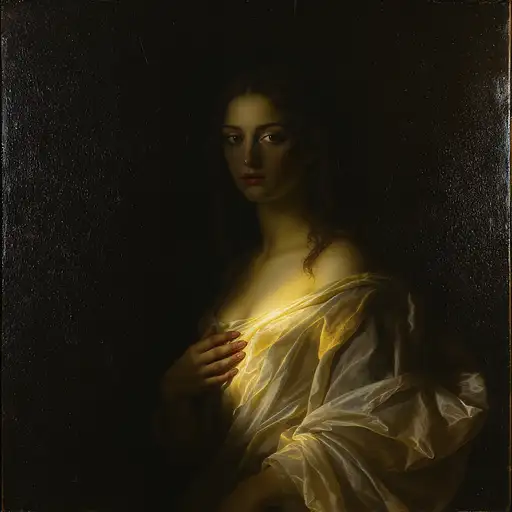
4 months ago
diaphanous ivory robe slipping off one shoulder::1.4 dramatic chiaroscuro with deep shadow enveloping half her form and a single candlelit god-ray grazing her face::1.6 oil on canvas in the style of Caravaggio::1.7 fine yet bold brushwork capturing glint on the camera lens, rich ochres and burnished umbers in the background::1.5
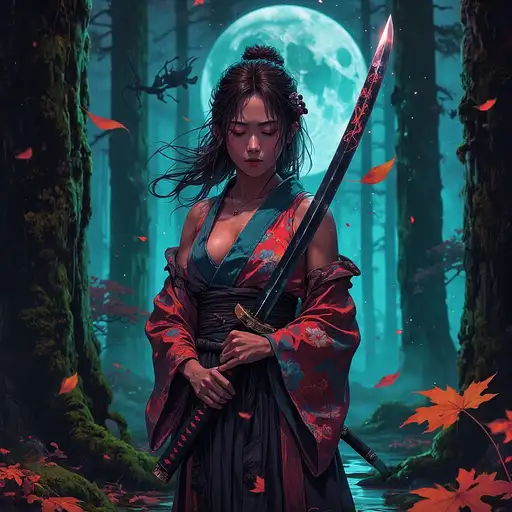
9 months ago
A serene yet intense scene in a dense, ancient forest during the stillness of twilight. The woman’s upper body fills the frame, her presence calm yet commanding. She holds a single, traditional Edo-period katana close to her face with both hands, the blade’s slightly curved edge gleaming faintly in the moonlight filtering through the towering trees. Her revealing kimono has slipped off one shoulder, clearly exposing one bare breast (visible and natural:1.8) while the other side remains draped, adding elegance and balance. The fabric, patterned with intricate floral designs, flutters gently in the wind, its vibrant reds and deep blues contrasting with the muted greens and browns of the forest. Her eyes are closed, her expression somber and contemplative, as though in prayer or deep focus. The katana’s blade reflects both the faint crescent moonlight and the ominous shadow of a demon, its smoky form hinted at in the polished steel. The hilt (tsuka) is tightly wrapped in black silk, simple yet refined, a testament to the weapon’s craftsmanship and purpose. The breeze stirs her slightly disheveled hair, adding subtle motion that complements the flowing fabric of her kimono. Around her, autumn leaves drift gracefully, their vivid reds and oranges framing her figure and creating depth in the composition. The interplay of light and shadow highlights the soft curves of her exposed form, the intricate details of her clothing, and the katana’s masterfully forged blade. The atmosphere is thick with quiet intensity, as though the forest itself holds its breath. The composition focuses entirely on her upper body, drawing attention to the poised katana, the reflection of unseen danger, and the serene yet powerful energy of her presence.
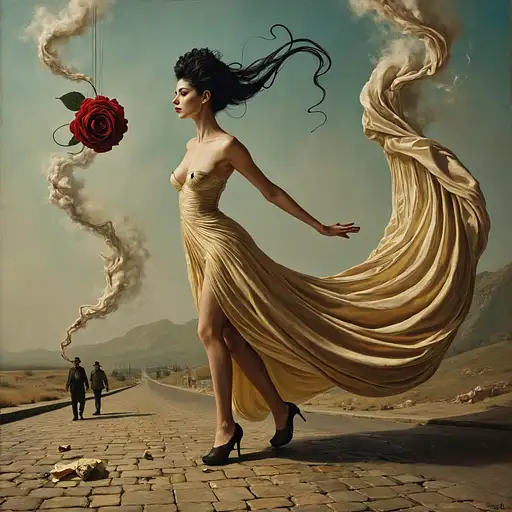
7 months ago
(Surrealism:1.7, Salvador Dalí late-life style:2.0, Dreamlike distortion:1.6, Hyperreal textures:1.5, Chiaroscuro contrast:1.4, Oil-painting brushstrokes:1.5, Organic fluidity:1.6, Metaphysical realism:1.4) A full-body surrealist portrait of a prostitute, painted in the unmistakable late-life style of Salvador Dalí, where dream logic dictates form and reality bends into its own subconscious reflection. She stands alone in the void, a lone figure frozen in motion yet melting into time itself. Her body is elongated but coherent, her limbs refined into one singular, fluid, organic motion, as if she is a sculpture made of half-formed candle wax, melting at the edges but never fully dissolving. Her face remains untouched by distortion, hyperreal and melancholic, eyes darkened with kohl, staring directly outward, unblinking, as if confronting time, fate, and the fabric of reality itself. A single strand of jet-black hair escapes from her carefully pinned curls, swaying in an invisible breeze. Her lips—painted a deep, blood-red—drip slightly at the edges, as if smeared by unseen hands, caught between seduction and sorrow. Her dress, a relic of the past, is a contradiction of luxury and decay, the hem transforming into thin wisps of smoke, curling and dispersing into the canvas. The fabric is stretched unnaturally, its folds elongating like the melted forms of Dalí’s classic clocks, one shoulder slipping in an eternal descent, never quite falling. The setting is an infinite, surreal landscape—a lonely street with no visible end, where shadows stretch longer than their owners, and the cobblestones appear to melt into liquid mercury. In the background, a large, antique pocket watch, twisted and partially submerged in the air, hangs frozen at an uncertain hour, its hands warped into elongated spirals. A single red rose, impossibly large and impossibly alive, hovers just behind her, its petals peeling away like fragments of forgotten love letters. The air feels thick, painted with visible brushstrokes, where light and shadow do not obey the laws of physics—instead, they bleed into one another, wrapping around her body in soft, liquid chiaroscuro, mimicking the curvature of a dream. She is not merely a woman but a symbol—of desire, of loss, of something slipping through time like sand through Dalí’s own fingers.

5 months ago
(Full-body shot, fine art noir photography, 1950s–1960s vintage setting, cinematic chiaroscuro lighting, ultra-realistic rendering, moody and atmospheric, sensual yet elegant, masterful composition, soft film grain, rich textures, timeless erotica aesthetic) A seductive nude woman stands in a dimly lit 1950s boudoir, her back to the camera, the curve of her spine accentuated by the flickering glow of a single vintage table lamp. A lush black fur boa drapes across her bare shoulders, cascading down her arms, its luxurious texture framing the smooth, radiant skin beneath. Silk stockings hug her legs, their delicate sheen catching the ambient light, a subtle garter barely visible. Her posture is both effortless and deliberate, hips slightly tilted, her weight shifted onto one foot, evoking a raw yet refined sensuality. A hazy mirror reflects just enough of her face in profile, lips painted a deep red, parted slightly as she gazes at her own reflection—lost in thought, desire, or a silent secret only she knows. The room exudes mid-century allure—a velvet chaise lounge, a half-empty glass of whiskey on a dark wood vanity, soft shadows stretching across plush drapes and antique furniture. The atmosphere is thick with desire, erotic yet sophisticated, a scene torn from the golden age of film noir where temptation lingers in the air, and every detail whispers luxury, mystery, and seduction.

2 months ago
fine Art photography, Brutalist high Fashion close up on face photo of a 24 year old Beja-Arapaho female modern-day goddess with Menacing intensity expression. Her body is Firm biceps that gently curve into the forearms, toned muscles, abs, small breast, flat chest. She has Dry skin with rough patches, especially on the elbows and knees. The skin pores and texture are clearly visible and in focus. Her Oval with wavy edges, Soft, muted yellow eyes, framed by long, elegant eyelashes. Her haircut is Pixie with textured top. Her haircolor is Rose gold hair. Her eyebrows are High-angled arch shaped, complementing her delicate facial features. Her outfit is Stark geometric cutout jacket, midriff, Exposed zipper utility trousers, She poses in She strikes a dynamic pose with one hand in her hair and the other hand placed on her thigh, conveying energy and movement.. in the background Massive concrete silos, lights Concrete slab pierced by a single beam in the style of Helmut Newton

4 months ago
A serene and contemplative scene for the evening. A lone figure, silhouetted against a vast, star-filled cosmic expanse, sits peacefully on a floating island of ancient, gnarled tree roots. This island gently drifts through a softly glowing nebula of deep blues, purples, and shimmering golds. Above the figure, a single, enormous, transparent celestial sphere hovers, containing a miniature, intricate galaxy within it, symbolizing knowledge and the universe's mysteries. The lighting is ethereal starlight and the soft, internal glow of the nebula, casting long, peaceful shadows. The style is Studio Ghibli-inspired, with a dreamy, painterly aesthetic reminiscent of watercolors. The overall atmosphere is one of profound tranquility, quiet introspection, and boundless wonder, inviting the viewer to contemplate their place in the cosmos. High resolution, perfectly clear. Mobile-friendly aspect ratio. --no text, --no sharp edges, --no jarring elements, --no overly complex details

6 months ago
illustrate the four seasons of a single landscape in one continuous panoramic image. From left to right, transition from winter to spring to summer to fall. Start with a snow-covered forest, then show the same trees budding with new leaves, followed by lush summer growth, and ending with autumn colors. Include a small cabin that remains constant throughout, but show how its surroundings change. Subtly alter the lighting from cool winter tones to warm summer hues and back to the golden light of fall

8 months ago
Fantasy girl wearing peasant top. Has a single black braid coming over one shoulder. She has black hair and crystal green eyes with blue skin. High resolution photography interior design, dreamy sunken living room conversation pit, wooden floor, small windows opening onto the garden, bauhaus furniture and decoration, high ceiling, beige blue salmon pastel palette, interior design magazine, cozy atmosphere; 8k, intricate detail, photorealistic, realistic light, wide angle, kinkfolk photography, A+D architecture
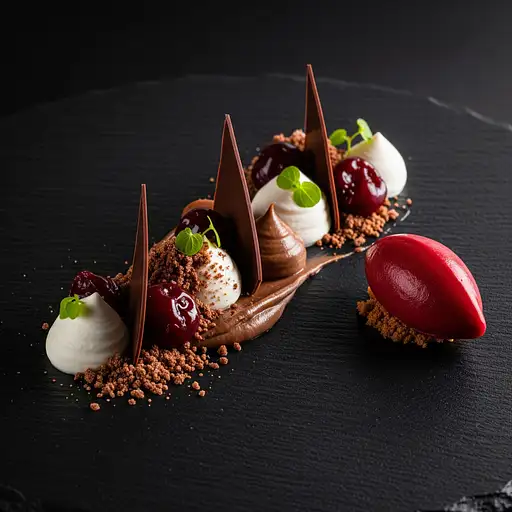
4 months ago
A deconstructed Black Forest gateau, presented in the style of a Michelin-star restaurant's haute cuisine. On a dark, minimalist slate plate, the individual components of the classic cake are artfully arranged. There is a smear of rich chocolate ganache, perfectly placed kirsch-infused cherries, delicate dollops of whipped cream, a sprinkle of 'chocolate soil' for texture, and thin, elegant shards of dark chocolate standing vertically. A single, smooth quenelle of deep red cherry sorbet sits to one side. The plating is clean and precise, and the dish is captured with dramatic, focused lighting that emphasizes the different textures and colors. The image should evoke a sense of modern culinary artistry applied to a traditional German dessert.
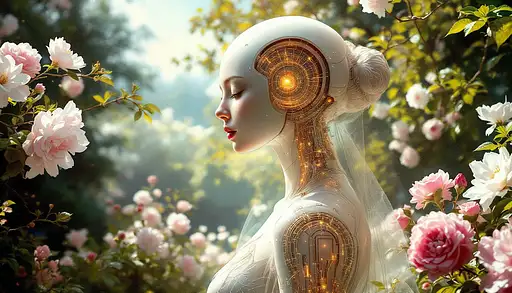
6 months ago
(Primary Subject: Emotionally Expressive Android Woman with Dual-Layered Skin, Painted in Impressionist Classical Renaissance Style, 1.7 weight) — in the heart of a lush, sun-drenched garden overflowing with blossoms, an android woman stands quietly, her form captured in the painterly elegance of a Renaissance-era oil painting. Her body is sculpted and graceful, rendered with soft impressionist brushstrokes that blend into surreal detail—her figure radiant, yet ethereal, like a machine-angel frozen in time. Her “skin” is composed of two delicate, interwoven layers: The outer layer is smooth, reflective, and subtly fluid, shimmering with hints of pale pink, soft violet, and dusky gold, like liquid mercury caught in a sunset. It has the appearance of gently flowing molten glass, and catches the dappled garden light with painterly elegance. Beneath it, faintly visible through the translucent surface, lies a subdermal lattice—a softly glowing core of golden circuitry, like sacred geometry woven into synthetic muscle. It pulses faintly, like a slow heartbeat of light, giving her form an inner radiance, a soul made of signal (subtle luminous inner structure beneath transparent surface, 1.6 weight). She wears no armor, no exposed wires—only that liquid-smooth surface, glowing softly in the sun. A thin, continuous line of amber-orange light traces up the outside of her legs, over her hips, across her shoulders and arms, like a haloed signature etched into her form. Her visor-like faceplate—a curved golden-glass surface—reflects the garden’s warm light. Though faceless, her entire body language conveys profound emotion: one hand lightly touching her chest, the other extended gently toward a single open flower, as if remembering something. Her posture is soft, tender, almost melancholic—like a saint carved from future metal, lost in sacred thought. The garden blooms around her in classical beauty—roses, lilies, orchids, and surreal blossoms from impossible species. Sunlight pours through foliage in golden beams, casting her figure in a divine backlight. Petals drift in the air like thoughts. Her reflection shimmers faintly in a nearby pool. Rendered in the style of a classical oil painting—with visible brush textures, soft baroque lighting, volumetric haze, and subtle chiaroscuro across her form. The colors are rich and warm—sunset gold, floral crimson, blush pink, and soft lavender—interplaying with reflections in her skin like a moving canvas.
